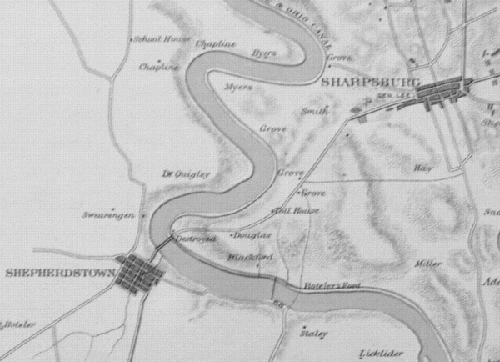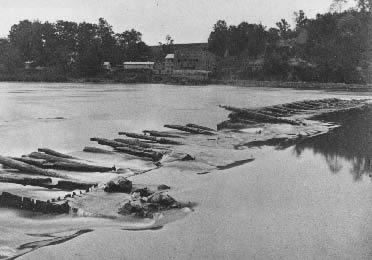
Map
detail from Sheet #1, Plate XXIX, in the
Atlas to Accompany the Official Records of the Union and Confederate
Armies,
Government Printing Office, Washington, DC, 1891-1895. [Available
in reprint editions.]
There are several maps of the Antietam campaign in this collection.
This one
is of particular interest because it shows the dam for Botelor's Mill,
the mill buildings,
and Botelors Ford, with the roads leading to and from the ford. The
bridge to
Shepherdstown is shown on several of the maps, but labelled "destroyed."
|
To be added
Mile
71.4:
Jackson's legendary quartermaster, Major Harmon, was once again in
find form, "cussing across the wagons" as he had two weeks
earlier at Whites Ford (see Mile 38.9).
Mile
71.7:
Though he built the mill with the grain trade in mind, Dr. Henry Botelor
was alert to the potential use of local limestone for cement, and
corresponded with President Mercer of the C&O in January 1828
to offer his services. Botelor could offer his cement at a much lower
rate than the competitive suppliers in New York because of his convenient
proximity to the canal works. Until 1837, when the Roundtop Mill started
operation (see mile 127.4), Botelor was the primary supplier
of cement to the C&O Canal. The relationship was symbiotic, as
the mill became so dependent on the C&O to ship its cement that
it occasionally had to cease operation because of low water in the
canal. Though the Shepherdstown river lock was nearly a mile upstream,
records indicate that the mill was also dependent on its being in
good repair so that the cement could be boated across the Potomac
and into the canal.
Henry
Botelor died in 1836, and his 21-year old son Alexander, one year
out of Princeton University and newly married, inherited his business
concerns and an unfortunate amount of debt. The mill continued to
produce cement for use in Baltimore, Georgetown, and Washington, and
in 1851 received a contract to provide cement for the U.S. Capitol.
Beginning in 1852, however, Alexander Botelor began leasing the mill
to a Mr. Reynolds.
Because
of Alexander Botelor's active participation in the Confederate cause,
Union troops burned the mill on August 19, 1861. When General Hunter
began the practice of burning the private homes of secessionists in
the summer of 1864, Botelor's house was among the properties destroyed.
The mill was restored to operation in 1867, and was continued, with
occasional interruptions due to flooding, by Major Harry Woodward
Blunt. The business finally came to a grinding halt when Major Blunt
died in 1901.
|
Documents
Lt.
Colonel Blackford's account of the cavalry crossing after the battle
of Antietam:
Towards evening General Stuart came back to where he left his staff,
to go to an interview with General Lee, to which he had been summoned,
and told me he wished to proceed at once and examine the Potomac River
in our rear above the regular ford near Shepherdstown, and find, if
possible, a ford by which cavalry could cross, and that I must do
this without making inquiries among citizens; that if suc a crossing
could be found, to place some men at it and station a line of men
at intervals of a couple of hundred yards along the route leading
to the pace so that I could guide a column of cavalry to it in the
dard without fail, and theat I must report to him by sundown. There
was no time to be lost, so taking twenty men I started at a rapid
trot to the river and then up the banks of the stream, noticing carefully
every indication of shallow water. The only way to prove the fact
was to ride in until the water became too deep, and in this way I
son became wet up to my neck, for sometimes Magic would step off a
ledge into swimming water.
At last, however, I found a crossing just below a fish trap where
a shallow dam had been built of loose stones over which the water
poured. For a distance of ten or fifteen yards below this dam the
water was shallow enough for fording and then it became deeper and
deeper until it was clear past the saddle. The place was very rough
and the water swift, but it was the best that could be had; so after
crossing several times to learn the position of some dangerous places,
I stationed a picket at the bank to with orders to answer my call
if I came in the dark, and returned to General Stuart, noticing carefully
the unmarked route and leaving men along at intervals to guide from
one to the other.
***
As soon as it was dark, fires were lighted all along our lines as
usual, but the movement to the rear soon showed that my surmise was
correct and that the army was going to cross back into Virginia. First
the wagon trains, then the artillery, and then the infantry took up
the line of march to and across the river. I was sent to guide Hampton's
brigade to the ford I had found, and reached it without trouble, thanks
to precautions taken, for it was very dark and a heavy fog arose from
the river, wrapping everything in an impenetrable veil of mist.
The head of the column by my guidance, keeping close to the fish
dam, crossed safely, but then there occurred one of those mishaps
which will occur in war even after every conceivable precaution apparently
has been taken. As before stated, the ford was a narrow one, along
just below the fish dam; below this the water was deep and swift,
and the distance across the river at this pace was considerable. The
fog was so thick that only a few horses' lengths in front could be
seen, and in the column each horseman followed the one before him.
Each horse was pressed to a certain extent downstream, and not having
been told that they must keep close to the fish dam, they followed
their leaders all the time, losing ground by the current as they advanced.
The result was that the rear of the column found itself in swimming
water and had great difficulty in saving itself. Some men, I believe,
were drowned and several horses were lost. The right thing would have
been to post men all along the ford on the lower side, but this no
one thought of until too late.
General
Walker's account of the crossing of the main body of Lee's army:
Detained in superintending the removal of a number of the wounded
of my division, I was among the last to cross the Potomac. As I rode
into the river I passed General Lee, sitting on his horse in the stream,
watching the crossing of the wagons and artillery. Returning my greeting,
he inquired as to what was still behind. here was nothing but the
wagons containing my wounded, and a battery of artillery, all of which
were near at hand, and I told him so. "Thank God!" I heard
him say as I rode on.
|
|

The
dam for Botelor's Mill in ruins, with mill buildings in the background--
probably
the result of flood damage and neglect after it closed in the early
1900s.
The intrepid explorer can still find many remains: the stone mill, the
office
building along the river road, the limekilns upstream of the dam, and
timbers and spikes on the river bottom along the line of the dam.
Photo from Library of Congress.
|
|
Sources:
- Alexander
Robinson Botelor, Wheelhouse of Whiggery, Stonewall's Courier,
compiled and edited by Charles S. Adams, Co-editor John S. Watterson
III, Shepherdstown, West Virginia, 1998. [The Appendices reprint some
of Botelor's autobiographical essays.]
- Cement
Mills Along the Potomac River, by Thomas F. Hahn & Emory L.
Kemp, Institute for the History
of Technology and Industrial Archeology,
West Virginia University, Monograph Series Volume 2, Number 1, 1994
- War
Years with Jeb Stuart, by Lieutenant Colonel W.W. Blackford, originally
published in 1945 by Charles Scribner, republished with new editorial
material by Louisiana State University
Press, 1993 Used by permission of the Press. [Compare
Blackford's and McClellan's account of the cavalry crossing at Rowser's
Ford]
- Make
Me a Map of the Valley--The Civil War Journal of Stonewall Jackson's
Topographer, Jedediah Hotchkiss,
edited by Archie P. McDonald, Southern
Methodist University Press, 1973. [Hotchkiss was ordered to located
the route to the primary ford used by the army; he describes Major
Harmon as "cussing" the army train across the river.]
- "Harper's
Ferry and Sharpsburg," by (General) John G. Walker, in The
Century Magazine, vol. 32, issue 2, June 1886, pp. 296-309. [Viewable
on-line as a part of Cornell University's Making
of America collection.]
- Also
see Limekilns in this collection.
|


